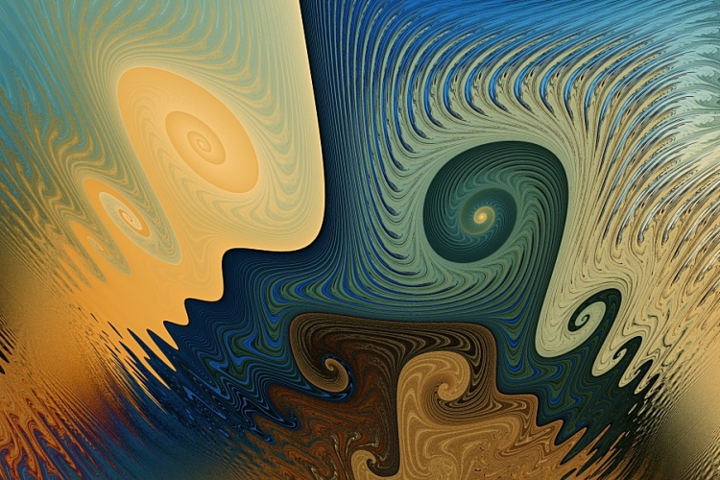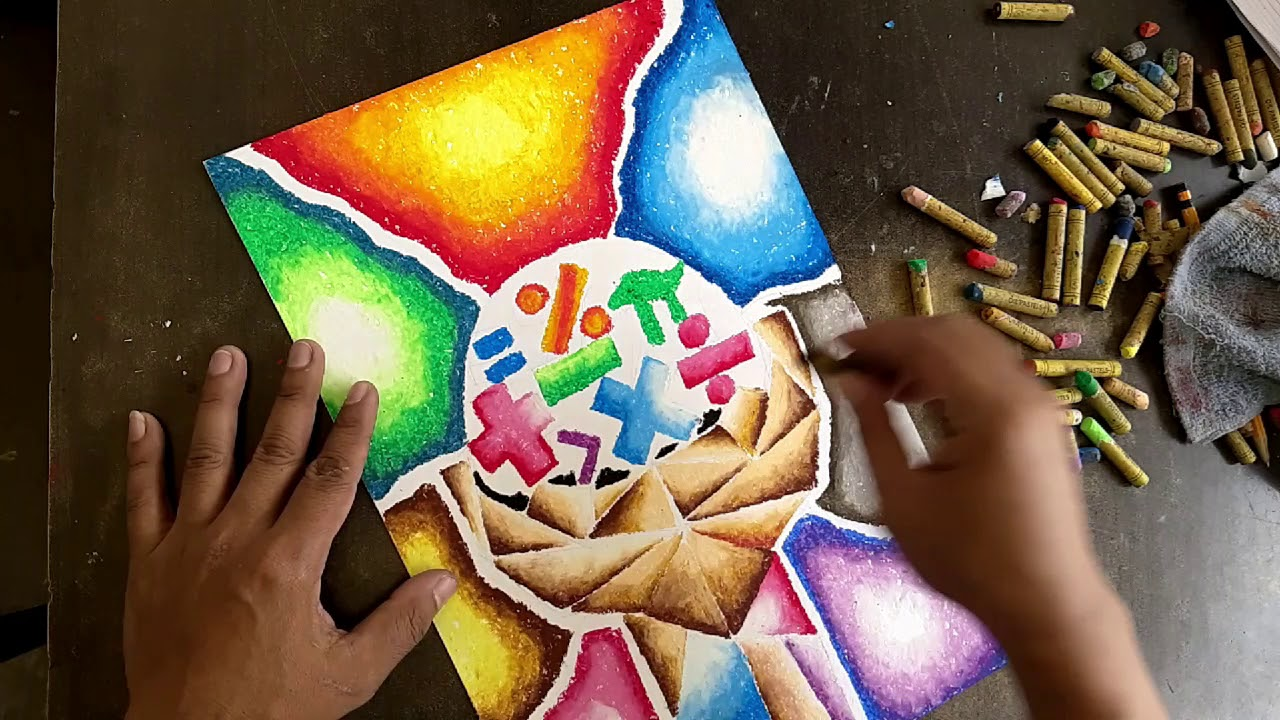An unexpected kinship thrives in the seemingly disparate realms of mathematics and art, hidden beneath the surface of divergent disciplines. At first glance, one might perceive mathematics as a rigid framework of abstract concepts and equations, while art appears to be an expressive realm bound by imagination and creativity. But it might be surprising to know that there is a subtle role of math in art.
Delving deeper reveals an intricate interplay between these seemingly contradictory domains, where the principles of mathematics provide a foundation upon which artistic expression flourishes. Just as words can brighten someone’s day, numbers, too, play a hidden role in creativity — the link between mathematics and art is seen in balance, proportion, and symmetry. Exploring maths in art examples, like the Golden Ratio or geometric patterns, shows clearly how math is used in art to create harmony, proving that arts with maths is not just theory but visible in paintings, architecture, and design.

Art and Maths Connection

The connection between art and mathematics is rich and multifaceted, transcending the conventional boundaries that separate these seemingly distinct disciplines. Beneath the surface, they share fundamental principles that form the very essence of their existence. This intricate relationship can be explored through various key concepts:
Geometry and Proportion
- Golden Ratio: The golden ratio, approximately 1.618, is a mathematical constant revered for its aesthetic appeal. It appears in countless works of art, from the Parthenon in ancient Greece to Leonardo da Vinci's "Vitruvian Man." This ratio governs the proportions of elements within a composition, contributing to a sense of balance and harmony.
- Fibonacci Sequence: Found in natural forms like pinecones and sunflowers, the Fibonacci sequence (0, 1, 1, 2, 3, 5, 8, 13, 21, ...) is a numerical pattern where each term is the sum of the two preceding ones. Artists often incorporate these proportions to create visually pleasing and organic arrangements.
Symmetry and Balance
- Reflective Symmetry: Mathematics defines various types of symmetry, and artists leverage them to create balanced and visually engaging compositions. Reflective symmetry, where one half mirrors the other, is common in art and architecture.
- Rotational Symmetry: This type of symmetry, where an object looks the same after a certain amount of rotation, is exemplified in Islamic geometric patterns and the work of artists like M.C. Escher.
Perspective and Space
- Linear Perspective: Developed during the Renaissance, linear perspective uses mathematical principles to create the illusion of depth and three-dimensionality on a two-dimensional surface. This technique revolutionised the representation of space in art.
- Fractal Geometry: A branch of mathematics, fractal geometry deals with infinitely complex, self-replicating patterns. Artists like Jackson Pollock and Benoît Mandelbrot have used fractal-like forms in their work, blurring the lines between the mathematical and the artistic.
Algorithmic Art
- Generative Art: This genre of art employs algorithms to produce artwork. Artists write code that defines rules and parameters, allowing the computer to generate visual output. This form of art challenges traditional notions of authorship and creativity.
Kinetic Art
- Mathematical Motion: Kinetic art uses precise calculations to create dynamic, moving sculptures. Artists like Alexander Calder and Jean Tinguely used mathematical principles to design their kinetic artworks.
Topology and Modern Art
- Topological Forms: Concepts from topology, a branch of mathematics dealing with properties preserved under continuous transformations, have influenced artists like Henry Moore and Barbara Hepworth. Their sculptures often embody topological ideas.
Digital Art and Fractals
- Mandelbrot Set: The Mandelbrot set, a famous fractal, has been a wellspring of inspiration for digital artists. Its infinitely complex and intricate patterns serve as a canvas for creative exploration.
The relation between art and mathematics continues to evolve, with contemporary artists and mathematicians pushing the boundaries of what is possible. From computer-generated art to the fusion of virtual reality and mathematical algorithms, this dynamic relationship promises a future of boundless creative potential, where the lines between art and mathematics blur ever further.
Art Elements Requiring Mathematical Understanding

The elements of art and mathematics share an intricate relationship, with mathematical principles underpinning many aspects of artistic creation. Here are some key elements of art that are influenced by mathematics:
Line
- Mathematical Precision: Lines in art can be perfectly straight or curved with mathematical precision. Using rulers, compasses, and other geometric tools allows artists to create precise and calculated lines in their compositions.
- Fractal Lines: Artists may also incorporate fractal-like patterns into their work, where intricate shapes comprise smaller, self-replicating versions of themselves. This concept is rooted in the mathematical field of fractal geometry.
Shape
- Geometry: Shapes in art often adhere to geometric principles. Circles, squares, triangles, and other polygons form the basis for creating a wide range of shapes in two-dimensional and three-dimensional art.
- Symmetry and Tessellations: Artists use mathematical concepts of symmetry to create balanced and visually appealing shapes. Tessellations, or repeating patterns of shapes, are another manifestation of mathematical precision in art.
Form
- Three-Dimensional Space: Artists use mathematics to create the illusion of a three-dimensional form on a two-dimensional surface—techniques like shading, perspective, and foreshortening use mathematical principles to convey depth and volume.
- Geometric Solids: Artists may incorporate three-dimensional geometric shapes (such as cubes, spheres, and cylinders) into sculptures or paintings, using mathematical principles to represent these forms accurately.
Space
- Linear Perspective: Linear perspective, a mathematical concept, creates the illusion of depth and space on a flat surface. It involves using converging lines to represent the way objects appear to recede into the distance.
- Atmospheric Perspective: This technique relies on mathematical principles of colour and light to create the illusion of depth by adjusting the brightness and saturation of distant objects.
Texture
- Patterns and Repetition: Mathematical concepts like tessellations and fractals can be used to create intricate and visually engaging textures in art.
Colour
- Colour Theory: Color theory, which includes concepts like the colour wheel, complementary colours, and colour harmonies, has mathematical underpinnings. It involves understanding the relationships and proportions between different hues.
- Digital Art and RGB Values: In digital art, colours are often specified using Red, Green, and Blue (RGB) values, numerical representations of colour intensities.
Value
- Grayscale and Gradient: Value in art refers to the range of lightness and darkness. Artists use mathematical principles to create smooth gradients and accurately represent the tonal variations in their compositions.
Movement
- Kinetic Art: Kinetic art incorporates movement into the artwork and often relies on precise mathematical calculations to create dynamic and interactive pieces.
- In essence, the elements of art are deeply intertwined with mathematical concepts. Artists draw upon these principles to create works that are not only visually compelling but also intellectually engaging, showcasing the profound and enduring connection between art and mathematics.
Famous Paintings in the World and Math Behind It

Many famous paintings throughout history have been influenced by mathematical principles, either consciously or unconsciously. Here are some famous paintings in the world and math behind it:
"The Last Supper" by Leonardo da Vinci
- Linear Perspective: Leonardo da Vinci was a pioneer in using linear perspective in his paintings. In "The Last Supper," he employed this mathematical technique to create a sense of depth and three-dimensionality. The room's lines converge toward a central vanishing point, giving the illusion of distance.
- Golden Ratio: It is believed that da Vinci used the golden ratio to determine the proportions of the table, the positions of the figures, and the dimensions of the room. This ratio is often associated with aesthetic harmony.
"Starry Night" by Vincent van Gogh
- Fibonacci Sequence: Van Gogh's use of spirals and swirling patterns in "Starry Night" bears a resemblance to the Fibonacci sequence, which appears in many natural forms. This mathematical sequence is characterised by the growth of numbers based on a specific pattern.
"The Birth of Venus" by Sandro Botticelli
- Proportions and Golden Rectangle: Botticelli's composition of Venus is often said to embody the proportions of the golden rectangle, a shape closely related to the golden ratio. The balance and harmony in this painting are influenced by mathematical principles.
"Mona Lisa" by Leonardo da Vinci
- Sfumato Technique: Leonardo da Vinci's use of the sfumato technique, which involves the delicate blending of colours and tones, demonstrates an understanding of mathematical gradients and transitions between light and shadow.
"The Persistence of Memory" by Salvador Dalí
- Non-Euclidean Geometry: Dalí's melting clocks in this surrealist masterpiece evoke the concept of non-Euclidean geometry, where space is perceived in a distorted or unconventional manner. This idea was influenced by the mathematical theories of Albert Einstein.
"Guernica" by Pablo Picasso
- Cubism and Geometry: Picasso's development of Cubism involved a deconstruction of forms into geometric shapes, illustrating a mathematical approach to representation. The use of multiple perspectives and fragmented forms challenges traditional notions of spatial representation.
"Composition with Red, Blue, and Yellow" by Piet Mondrian
- Mathematical Abstraction: Mondrian's art is often associated with the De Stijl movement, which sought to distil art to its fundamental geometric elements. His use of precise lines, right angles, and primary colours reflects a mathematical approach to abstraction.
"Les Demoiselles d'Avignon" by Pablo Picasso
- Fractal-like Forms: In this groundbreaking work, Picasso introduced African art influences and distorted, angular forms. Some art historians argue that the fractured, angular shapes in the painting have similarities to fractal geometry.
These examples demonstrate how artists have drawn inspiration from mathematical concepts to create some of the most iconic and influential works of art in history. Through an understanding of geometry, proportion, perspective, and other mathematical principles, these artists were able to imbue their creations with a level of precision, balance, and visual appeal that continues to captivate audiences to this day.
Build a strong foundation in fundamentals with a maths class 10 to strengthen your basic concepts.
How to Make Art Using Maths

Here's a step-by-step guide to help you get started:
Understand Basic Mathematical Concepts
Familiarise yourself with fundamental mathematical principles such as geometry, symmetry, proportion, and perspective. These concepts form the foundation of the mathematical aspects of art.
Explore Geometry in Art
Study how geometric shapes can be used in art. Experiment with drawing basic shapes like circles, squares, triangles, and rectangles. Understand how these shapes can be combined and transformed to create more complex forms.
Learn about Proportions and Ratios
Delve into the concept of proportion, which is crucial for accurately representing objects and figures in art. Practice measuring and comparing proportions in your drawings.
Experiment with Symmetry
Understand different types of symmetry (e.g., reflective, rotational) and how they can be used to create balanced compositions. Practice drawing symmetrical objects and designs.
Study Linear Perspective
Learn the principles of linear perspective, which is essential for creating the illusion of depth and three-dimensionality on a two-dimensional surface. Experiment with drawing objects in perspective to develop this skill.
Explore the Golden Ratio and Fibonacci Sequence
Familiarise yourself with these mathematical concepts, which have been used in art for centuries. Experiment with incorporating the golden ratio and Fibonacci sequence into your compositions for aesthetic appeal.
Experiment with Fractals
Explore the concept of fractals, which are infinitely complex patterns that repeat at different scales. Experiment with creating your own fractal-like designs using mathematical algorithms.
Incorporate Technology
Use digital tools like graphic software or apps that allow you to apply mathematical principles directly. Programs like Adobe Illustrator or mathematical art generators can be particularly useful.
Study Mathematical Artists
Research artists who have incorporated mathematical concepts into their work. Analyse their techniques and try to apply similar principles in your own creations.
Combine Art and Math Projects
Create specific projects that focus on integrating mathematical concepts into your artwork. For example, you could design a piece using only geometric shapes or create a drawing with an emphasis on linear perspective.
Practice Regularly
Like any skill, learning to incorporate math into your art requires practice. Dedicate time to experimenting with mathematical concepts and applying them to your creations.
The goal is not only to create visually appealing art but also to develop a deeper understanding of how mathematical principles can enhance your creative process. Enjoy the journey of blending art and math and let your creativity flourish!
















Beautiful article! May I share it on my page?
Hey Swapnila,
Glad to hear that you like the article.
Please feel free to share it on your page. Don’t forget to mention our website/Instagram while sharing the blog.
Thanks!
love it
very helpful! but can i please use some of the info in my school project? i could find any other helpful site, yours was the best! please allow me to borrow some information. or else my maths teacher will kill me! thank you.
Absolutely! More than happy to help out!
very helpful! but can i please use some of the info in my school project? i could find any other helpful site, yours was the best! please allow me . or else my maths teacher will kill me! thank you.
hi,can you help me with a painting so as to what mathematical cocncept is used in it
Sure thing :)
Da Vinci employed the mathematical concepts of linear perspective such as parallel lines, the horizon line, and a vanishing point to give the impression of depth on a two-dimensional canvas. In The Annunciation, he utilized perspective to highlight the edge of a structure, an enclosed garden, and a pathway.